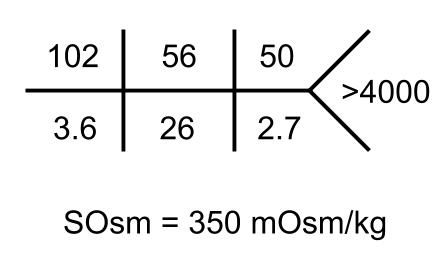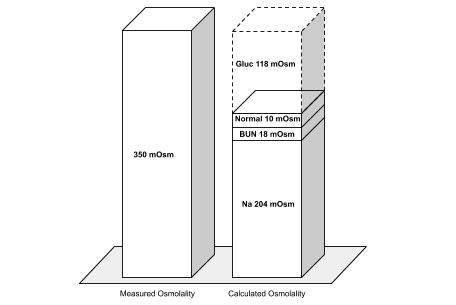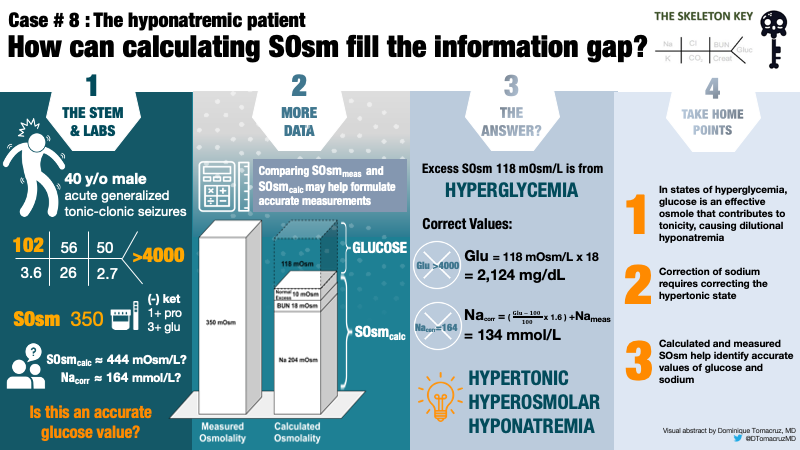1a/14
It’s 1:34 p.m. and the ED pages you for hyponatremia. https://abs.twimg.com/emoji/v2/... draggable="false" alt="📟" title="Pager" aria-label="Emoji: Pager">
https://abs.twimg.com/emoji/v2/... draggable="false" alt="📟" title="Pager" aria-label="Emoji: Pager">
A 45 y/o M with no known medical history presents after a seizure with a sodium of 102 mEq/L.
#tweetorial #MedTwitter #Nephtwitter #hyponatremia @theskeletonkeygroup
What& #39;s your first move?
It’s 1:34 p.m. and the ED pages you for hyponatremia.
A 45 y/o M with no known medical history presents after a seizure with a sodium of 102 mEq/L.
#tweetorial #MedTwitter #Nephtwitter #hyponatremia @theskeletonkeygroup
What& #39;s your first move?
1b/14
The initial evaluation of hyponatremia must “evaluate osmolality excluding hyperglycemia and other causes of non-hypotonic (SOsm >275) hyponatremia.” - per the European Guidelines (PMID: 24569125) https://abs.twimg.com/emoji/v2/... draggable="false" alt="🇪🇺" title="Flag of European Union" aria-label="Emoji: Flag of European Union">
https://abs.twimg.com/emoji/v2/... draggable="false" alt="🇪🇺" title="Flag of European Union" aria-label="Emoji: Flag of European Union"> https://abs.twimg.com/emoji/v2/... draggable="false" alt="🇪🇺" title="Flag of European Union" aria-label="Emoji: Flag of European Union">
https://abs.twimg.com/emoji/v2/... draggable="false" alt="🇪🇺" title="Flag of European Union" aria-label="Emoji: Flag of European Union"> https://abs.twimg.com/emoji/v2/... draggable="false" alt="🇪🇺" title="Flag of European Union" aria-label="Emoji: Flag of European Union">
https://abs.twimg.com/emoji/v2/... draggable="false" alt="🇪🇺" title="Flag of European Union" aria-label="Emoji: Flag of European Union">
We find a hyperosmolar hyponatremia:
The initial evaluation of hyponatremia must “evaluate osmolality excluding hyperglycemia and other causes of non-hypotonic (SOsm >275) hyponatremia.” - per the European Guidelines (PMID: 24569125)
We find a hyperosmolar hyponatremia:
2a/14
What is the most likely cause of hyponatremia?
What is the most likely cause of hyponatremia?
2b/14
Hyperglycemia-related hyponatremia is staring us in the face. https://abs.twimg.com/emoji/v2/... draggable="false" alt="👀" title="Eyes" aria-label="Emoji: Eyes">
https://abs.twimg.com/emoji/v2/... draggable="false" alt="👀" title="Eyes" aria-label="Emoji: Eyes">
In insulin deficiency/hyperglycemia, glucose is “effective” osmole, drawing fluid https://abs.twimg.com/emoji/v2/... draggable="false" alt="💦" title="Splashing sweat symbol" aria-label="Emoji: Splashing sweat symbol">from the intracellular
https://abs.twimg.com/emoji/v2/... draggable="false" alt="💦" title="Splashing sweat symbol" aria-label="Emoji: Splashing sweat symbol">from the intracellular https://abs.twimg.com/emoji/v2/... draggable="false" alt="➡️" title="Rightwards arrow" aria-label="Emoji: Rightwards arrow">extracellular space, diluting sodium.
https://abs.twimg.com/emoji/v2/... draggable="false" alt="➡️" title="Rightwards arrow" aria-label="Emoji: Rightwards arrow">extracellular space, diluting sodium.
Glucose Up https://abs.twimg.com/emoji/v2/... draggable="false" alt="📈" title="Chart with upwards trend" aria-label="Emoji: Chart with upwards trend"> , Sodium Down
https://abs.twimg.com/emoji/v2/... draggable="false" alt="📈" title="Chart with upwards trend" aria-label="Emoji: Chart with upwards trend"> , Sodium Down https://abs.twimg.com/emoji/v2/... draggable="false" alt="📉" title="Chart with downwards trend" aria-label="Emoji: Chart with downwards trend">
https://abs.twimg.com/emoji/v2/... draggable="false" alt="📉" title="Chart with downwards trend" aria-label="Emoji: Chart with downwards trend">
Hyperglycemia-related hyponatremia is staring us in the face.
In insulin deficiency/hyperglycemia, glucose is “effective” osmole, drawing fluid
Glucose Up
3/14
 https://abs.twimg.com/emoji/v2/... draggable="false" alt="⚠️" title="Warning sign" aria-label="Emoji: Warning sign">Reminder
https://abs.twimg.com/emoji/v2/... draggable="false" alt="⚠️" title="Warning sign" aria-label="Emoji: Warning sign">Reminder https://abs.twimg.com/emoji/v2/... draggable="false" alt="⚠️" title="Warning sign" aria-label="Emoji: Warning sign">
https://abs.twimg.com/emoji/v2/... draggable="false" alt="⚠️" title="Warning sign" aria-label="Emoji: Warning sign">
“Effective” osm (gluc, Na, mannitol)
-create osmotic gradient, increase tonicity, cause water to shift out of cells
“Ineffective “ osm (BUN, EtOH, glycine)
-no osmotic gradient, no change in tonicity, no water shifts
“Effective” osm (gluc, Na, mannitol)
-create osmotic gradient, increase tonicity, cause water to shift out of cells
“Ineffective “ osm (BUN, EtOH, glycine)
-no osmotic gradient, no change in tonicity, no water shifts
4a/14
 https://abs.twimg.com/emoji/v2/... draggable="false" alt="🛑" title="Stop sign" aria-label="Emoji: Stop sign">Hold on…
https://abs.twimg.com/emoji/v2/... draggable="false" alt="🛑" title="Stop sign" aria-label="Emoji: Stop sign">Hold on…
Glucose >4000 — greater than the laboratory limit of detection.
Did our patient set a new Guinness World Record for the highest sodium? https://abs.twimg.com/emoji/v2/... draggable="false" alt="🏆" title="Trophy" aria-label="Emoji: Trophy">
https://abs.twimg.com/emoji/v2/... draggable="false" alt="🏆" title="Trophy" aria-label="Emoji: Trophy">
Glucose >4000 — greater than the laboratory limit of detection.
Did our patient set a new Guinness World Record for the highest sodium?
4b/14
A sodium >4000 is probably incompatible with life and likely a laboratory error.
Houston, we have a problem. https://abs.twimg.com/emoji/v2/... draggable="false" alt="👨🏻🚀" title="Man astronaut (light skin tone)" aria-label="Emoji: Man astronaut (light skin tone)">
https://abs.twimg.com/emoji/v2/... draggable="false" alt="👨🏻🚀" title="Man astronaut (light skin tone)" aria-label="Emoji: Man astronaut (light skin tone)"> https://abs.twimg.com/emoji/v2/... draggable="false" alt="🚀" title="Rocket" aria-label="Emoji: Rocket">
https://abs.twimg.com/emoji/v2/... draggable="false" alt="🚀" title="Rocket" aria-label="Emoji: Rocket"> https://abs.twimg.com/emoji/v2/... draggable="false" alt="🌑" title="New moon symbol" aria-label="Emoji: New moon symbol">
https://abs.twimg.com/emoji/v2/... draggable="false" alt="🌑" title="New moon symbol" aria-label="Emoji: New moon symbol">
A sodium >4000 is probably incompatible with life and likely a laboratory error.
Houston, we have a problem.
5/14
Osmolality, the concentration of solute per kg of water, is used to help estimate a more accurate glucose measurement.
NA https://abs.twimg.com/emoji/v2/... draggable="false" alt="✖️" title="Heavy multiplication x" aria-label="Emoji: Heavy multiplication x"> 2
https://abs.twimg.com/emoji/v2/... draggable="false" alt="✖️" title="Heavy multiplication x" aria-label="Emoji: Heavy multiplication x"> 2
BUN https://abs.twimg.com/emoji/v2/... draggable="false" alt="➗" title="Heavy division sign" aria-label="Emoji: Heavy division sign"> 2.8
https://abs.twimg.com/emoji/v2/... draggable="false" alt="➗" title="Heavy division sign" aria-label="Emoji: Heavy division sign"> 2.8
Glucose https://abs.twimg.com/emoji/v2/... draggable="false" alt="➗" title="Heavy division sign" aria-label="Emoji: Heavy division sign"> 18
https://abs.twimg.com/emoji/v2/... draggable="false" alt="➗" title="Heavy division sign" aria-label="Emoji: Heavy division sign"> 18
Osmolality, the concentration of solute per kg of water, is used to help estimate a more accurate glucose measurement.
NA
BUN
Glucose
6a/14
Can we account for all the 350 mOsm we measured?
 https://abs.twimg.com/emoji/v2/... draggable="false" alt="⏳" title="Hourglass with flowing sand" aria-label="Emoji: Hourglass with flowing sand"> Na 102 x 2 = 204 mOsm
https://abs.twimg.com/emoji/v2/... draggable="false" alt="⏳" title="Hourglass with flowing sand" aria-label="Emoji: Hourglass with flowing sand"> Na 102 x 2 = 204 mOsm
 https://abs.twimg.com/emoji/v2/... draggable="false" alt="⏳" title="Hourglass with flowing sand" aria-label="Emoji: Hourglass with flowing sand"> BUN of 50 / 2.8 = 18 mOSm
https://abs.twimg.com/emoji/v2/... draggable="false" alt="⏳" title="Hourglass with flowing sand" aria-label="Emoji: Hourglass with flowing sand"> BUN of 50 / 2.8 = 18 mOSm
 https://abs.twimg.com/emoji/v2/... draggable="false" alt="⏳" title="Hourglass with flowing sand" aria-label="Emoji: Hourglass with flowing sand"> Normal osmol gap = 10 mOsm
https://abs.twimg.com/emoji/v2/... draggable="false" alt="⏳" title="Hourglass with flowing sand" aria-label="Emoji: Hourglass with flowing sand"> Normal osmol gap = 10 mOsm
 https://abs.twimg.com/emoji/v2/... draggable="false" alt="⏳" title="Hourglass with flowing sand" aria-label="Emoji: Hourglass with flowing sand"> Glucose of
https://abs.twimg.com/emoji/v2/... draggable="false" alt="⏳" title="Hourglass with flowing sand" aria-label="Emoji: Hourglass with flowing sand"> Glucose of  https://abs.twimg.com/emoji/v2/... draggable="false" alt="❓" title="Red question mark ornament" aria-label="Emoji: Red question mark ornament"> =
https://abs.twimg.com/emoji/v2/... draggable="false" alt="❓" title="Red question mark ornament" aria-label="Emoji: Red question mark ornament"> =  https://abs.twimg.com/emoji/v2/... draggable="false" alt="❓" title="Red question mark ornament" aria-label="Emoji: Red question mark ornament">
https://abs.twimg.com/emoji/v2/... draggable="false" alt="❓" title="Red question mark ornament" aria-label="Emoji: Red question mark ornament">
Can we account for all the 350 mOsm we measured?
6b/14
Measured: 350 mOsm
Calculated: 232 mOsm
The remaining 118 mOsm are due to glucose.
 https://abs.twimg.com/emoji/v2/... draggable="false" alt="🆒" title="Squared cool" aria-label="Emoji: Squared cool">
https://abs.twimg.com/emoji/v2/... draggable="false" alt="🆒" title="Squared cool" aria-label="Emoji: Squared cool"> https://abs.twimg.com/emoji/v2/... draggable="false" alt="🆒" title="Squared cool" aria-label="Emoji: Squared cool">
https://abs.twimg.com/emoji/v2/... draggable="false" alt="🆒" title="Squared cool" aria-label="Emoji: Squared cool"> https://abs.twimg.com/emoji/v2/... draggable="false" alt="🆒" title="Squared cool" aria-label="Emoji: Squared cool">
https://abs.twimg.com/emoji/v2/... draggable="false" alt="🆒" title="Squared cool" aria-label="Emoji: Squared cool">
Measured: 350 mOsm
Calculated: 232 mOsm
The remaining 118 mOsm are due to glucose.
7a/14
 https://abs.twimg.com/emoji/v2/... draggable="false" alt="🍿" title="Popcorn" aria-label="Emoji: Popcorn">POP QUIZ
https://abs.twimg.com/emoji/v2/... draggable="false" alt="🍿" title="Popcorn" aria-label="Emoji: Popcorn">POP QUIZ https://abs.twimg.com/emoji/v2/... draggable="false" alt="🍿" title="Popcorn" aria-label="Emoji: Popcorn">
https://abs.twimg.com/emoji/v2/... draggable="false" alt="🍿" title="Popcorn" aria-label="Emoji: Popcorn">
What is the conversion factor from mOsm/kg to mg/dL of glucose?
What is the conversion factor from mOsm/kg to mg/dL of glucose?
7b/14
18 x 118 mOsms = 2,124 mg/dL https://abs.twimg.com/emoji/v2/... draggable="false" alt="😮" title="Face with open mouth" aria-label="Emoji: Face with open mouth">
https://abs.twimg.com/emoji/v2/... draggable="false" alt="😮" title="Face with open mouth" aria-label="Emoji: Face with open mouth">
Not quite the Guinness World Record glucose of 2,656 mg/dl, but certainly an impressive value and much less than the laboratory reported >4000.
18 x 118 mOsms = 2,124 mg/dL
Not quite the Guinness World Record glucose of 2,656 mg/dl, but certainly an impressive value and much less than the laboratory reported >4000.
8a/14
To correct sodium for hypernatremia:
for every https://abs.twimg.com/emoji/v2/... draggable="false" alt="💯" title="Hundred points symbol" aria-label="Emoji: Hundred points symbol">mg/dL of glucose over
https://abs.twimg.com/emoji/v2/... draggable="false" alt="💯" title="Hundred points symbol" aria-label="Emoji: Hundred points symbol">mg/dL of glucose over  https://abs.twimg.com/emoji/v2/... draggable="false" alt="💯" title="Hundred points symbol" aria-label="Emoji: Hundred points symbol">we add a correction factor
https://abs.twimg.com/emoji/v2/... draggable="false" alt="💯" title="Hundred points symbol" aria-label="Emoji: Hundred points symbol">we add a correction factor  https://abs.twimg.com/emoji/v2/... draggable="false" alt="#️⃣" title="Keycap number sign" aria-label="Emoji: Keycap number sign">
https://abs.twimg.com/emoji/v2/... draggable="false" alt="#️⃣" title="Keycap number sign" aria-label="Emoji: Keycap number sign">
What correction factor do you like to use?
To correct sodium for hypernatremia:
for every
What correction factor do you like to use?
8b/14
Traditionally 1.6 is used.
Hiller et al proposed 2.4 (PMID: 10225241).
The nephrology fellows @NephBCM like @SaynaNorouzi use 2.0 to make it easy.
Traditionally 1.6 is used.
Hiller et al proposed 2.4 (PMID: 10225241).
The nephrology fellows @NephBCM like @SaynaNorouzi use 2.0 to make it easy.
9/14
Using measured gluc >4000, Na corrects to >164 https://abs.twimg.com/emoji/v2/... draggable="false" alt="❌" title="Cross mark" aria-label="Emoji: Cross mark">
https://abs.twimg.com/emoji/v2/... draggable="false" alt="❌" title="Cross mark" aria-label="Emoji: Cross mark">
Using calculated gluc 2,124, Na corrects to 134 https://abs.twimg.com/emoji/v2/... draggable="false" alt="✔️" title="Heavy check mark" aria-label="Emoji: Heavy check mark">
https://abs.twimg.com/emoji/v2/... draggable="false" alt="✔️" title="Heavy check mark" aria-label="Emoji: Heavy check mark">
We’ve done the mathematical heavy lifting https://abs.twimg.com/emoji/v2/... draggable="false" alt="🏋🏿" title="Person lifting weights (dark skin tone)" aria-label="Emoji: Person lifting weights (dark skin tone)">
https://abs.twimg.com/emoji/v2/... draggable="false" alt="🏋🏿" title="Person lifting weights (dark skin tone)" aria-label="Emoji: Person lifting weights (dark skin tone)"> https://abs.twimg.com/emoji/v2/... draggable="false" alt="💪" title="Flexed biceps" aria-label="Emoji: Flexed biceps">
https://abs.twimg.com/emoji/v2/... draggable="false" alt="💪" title="Flexed biceps" aria-label="Emoji: Flexed biceps">
Using measured gluc >4000, Na corrects to >164
Using calculated gluc 2,124, Na corrects to 134
We’ve done the mathematical heavy lifting
10/14
This is a case of hyperglycemia-related hyponatremia in the setting of Hyperglycemic Hyperosmolar State (HHS)
 https://abs.twimg.com/emoji/v2/... draggable="false" alt="1️⃣" title="Keycap digit one" aria-label="Emoji: Keycap digit one"> hyperglycemia
https://abs.twimg.com/emoji/v2/... draggable="false" alt="1️⃣" title="Keycap digit one" aria-label="Emoji: Keycap digit one"> hyperglycemia
 https://abs.twimg.com/emoji/v2/... draggable="false" alt="2️⃣" title="Keycap digit two" aria-label="Emoji: Keycap digit two"> hyperosmolality (>320)
https://abs.twimg.com/emoji/v2/... draggable="false" alt="2️⃣" title="Keycap digit two" aria-label="Emoji: Keycap digit two"> hyperosmolality (>320)
 https://abs.twimg.com/emoji/v2/... draggable="false" alt="3️⃣" title="Keycap digit three" aria-label="Emoji: Keycap digit three"> AMS/seizure
https://abs.twimg.com/emoji/v2/... draggable="false" alt="3️⃣" title="Keycap digit three" aria-label="Emoji: Keycap digit three"> AMS/seizure
 https://abs.twimg.com/emoji/v2/... draggable="false" alt="4️⃣" title="Keycap digit four" aria-label="Emoji: Keycap digit four"> absent ketones
https://abs.twimg.com/emoji/v2/... draggable="false" alt="4️⃣" title="Keycap digit four" aria-label="Emoji: Keycap digit four"> absent ketones
This is a case of hyperglycemia-related hyponatremia in the setting of Hyperglycemic Hyperosmolar State (HHS)
11/14
Let’s treat the patient. https://abs.twimg.com/emoji/v2/... draggable="false" alt="💉" title="Syringe" aria-label="Emoji: Syringe">
https://abs.twimg.com/emoji/v2/... draggable="false" alt="💉" title="Syringe" aria-label="Emoji: Syringe">
With insulin, cells consume glucose, fluid shifts back from the extracellular https://abs.twimg.com/emoji/v2/... draggable="false" alt="➡️" title="Rightwards arrow" aria-label="Emoji: Rightwards arrow"> intracellular, correcting Na in the process.
https://abs.twimg.com/emoji/v2/... draggable="false" alt="➡️" title="Rightwards arrow" aria-label="Emoji: Rightwards arrow"> intracellular, correcting Na in the process.
Timing https://abs.twimg.com/emoji/v2/... draggable="false" alt="⌚️" title="Wristwatch" aria-label="Emoji: Wristwatch"> of correcting blood glucose is a rate of 50 - 75 mg/dL/hr per the ADA (PMID: 19564476)
https://abs.twimg.com/emoji/v2/... draggable="false" alt="⌚️" title="Wristwatch" aria-label="Emoji: Wristwatch"> of correcting blood glucose is a rate of 50 - 75 mg/dL/hr per the ADA (PMID: 19564476)
Let’s treat the patient.
With insulin, cells consume glucose, fluid shifts back from the extracellular
Timing
12a/14
So why did the patient have a seizure? https://abs.twimg.com/emoji/v2/... draggable="false" alt="🤔" title="Thinking face" aria-label="Emoji: Thinking face">
https://abs.twimg.com/emoji/v2/... draggable="false" alt="🤔" title="Thinking face" aria-label="Emoji: Thinking face">
So why did the patient have a seizure?
12b/14
HHS may cause altered mental status, seizures, and death, but the exact pathophysiology is unclear.
Whereas rapid changes in osmolality cause cerebral edema in children https://abs.twimg.com/emoji/v2/... draggable="false" alt="👶🏼" title="Baby (medium light skin tone)" aria-label="Emoji: Baby (medium light skin tone)">, it very rarely occurs in adults
https://abs.twimg.com/emoji/v2/... draggable="false" alt="👶🏼" title="Baby (medium light skin tone)" aria-label="Emoji: Baby (medium light skin tone)">, it very rarely occurs in adults  https://abs.twimg.com/emoji/v2/... draggable="false" alt="👴" title="Older man" aria-label="Emoji: Older man">.
https://abs.twimg.com/emoji/v2/... draggable="false" alt="👴" title="Older man" aria-label="Emoji: Older man">.
Idunno, bro!
HHS may cause altered mental status, seizures, and death, but the exact pathophysiology is unclear.
Whereas rapid changes in osmolality cause cerebral edema in children
Idunno, bro!
13/14
In this case, the patient was admitted to ICU, received intravenous fluids and insulin per HHS protocol.
Glucose Down https://abs.twimg.com/emoji/v2/... draggable="false" alt="📉" title="Chart with downwards trend" aria-label="Emoji: Chart with downwards trend">, Sodium Up
https://abs.twimg.com/emoji/v2/... draggable="false" alt="📉" title="Chart with downwards trend" aria-label="Emoji: Chart with downwards trend">, Sodium Up  https://abs.twimg.com/emoji/v2/... draggable="false" alt="📈" title="Chart with upwards trend" aria-label="Emoji: Chart with upwards trend">
https://abs.twimg.com/emoji/v2/... draggable="false" alt="📈" title="Chart with upwards trend" aria-label="Emoji: Chart with upwards trend">
Sodium improved to 134, exactly our estimation! https://abs.twimg.com/emoji/v2/... draggable="false" alt="🤗" title="Hugging face" aria-label="Emoji: Hugging face">
https://abs.twimg.com/emoji/v2/... draggable="false" alt="🤗" title="Hugging face" aria-label="Emoji: Hugging face">
In this case, the patient was admitted to ICU, received intravenous fluids and insulin per HHS protocol.
Glucose Down
Sodium improved to 134, exactly our estimation!
14/14
To summarize:
 https://abs.twimg.com/emoji/v2/... draggable="false" alt="1️⃣" title="Keycap digit one" aria-label="Emoji: Keycap digit one">Glucose is “effective” osmole, drawing fluid from the intracellular to the extracellular space, diluting sodium.
https://abs.twimg.com/emoji/v2/... draggable="false" alt="1️⃣" title="Keycap digit one" aria-label="Emoji: Keycap digit one">Glucose is “effective” osmole, drawing fluid from the intracellular to the extracellular space, diluting sodium.
 https://abs.twimg.com/emoji/v2/... draggable="false" alt="2️⃣" title="Keycap digit two" aria-label="Emoji: Keycap digit two">Accurate measurements of serum osmolality and glucose help to predict the corrected sodium.
https://abs.twimg.com/emoji/v2/... draggable="false" alt="2️⃣" title="Keycap digit two" aria-label="Emoji: Keycap digit two">Accurate measurements of serum osmolality and glucose help to predict the corrected sodium.
To summarize:
Check out the visual abstract and full blog post at: https://renalfellow.org/2020/05/11/skeleton-key-group-electrolyte-case-8/
Special">https://renalfellow.org/2020/05/1... thank you to these great people, among others!
@DTomacruzMD, @amyaimei, @SaynaNorouzi, @kkalra_22, @iheartkidneys, @NephroGuy, @RyannSohaney, @drM_sudha, @kidney_boy, @TheSkeletonKG
Special">https://renalfellow.org/2020/05/1... thank you to these great people, among others!
@DTomacruzMD, @amyaimei, @SaynaNorouzi, @kkalra_22, @iheartkidneys, @NephroGuy, @RyannSohaney, @drM_sudha, @kidney_boy, @TheSkeletonKG

 Read on Twitter
Read on Twitter https://abs.twimg.com/emoji/v2/... draggable="false" alt="🇪🇺" title="Flag of European Union" aria-label="Emoji: Flag of European Union">https://abs.twimg.com/emoji/v2/... draggable="false" alt="🇪🇺" title="Flag of European Union" aria-label="Emoji: Flag of European Union">We find a hyperosmolar hyponatremia:" title="1b/14The initial evaluation of hyponatremia must “evaluate osmolality excluding hyperglycemia and other causes of non-hypotonic (SOsm >275) hyponatremia.” - per the European Guidelines (PMID: 24569125) https://abs.twimg.com/emoji/v2/... draggable="false" alt="🇪🇺" title="Flag of European Union" aria-label="Emoji: Flag of European Union">https://abs.twimg.com/emoji/v2/... draggable="false" alt="🇪🇺" title="Flag of European Union" aria-label="Emoji: Flag of European Union">https://abs.twimg.com/emoji/v2/... draggable="false" alt="🇪🇺" title="Flag of European Union" aria-label="Emoji: Flag of European Union">We find a hyperosmolar hyponatremia:" class="img-responsive" style="max-width:100%;"/>
https://abs.twimg.com/emoji/v2/... draggable="false" alt="🇪🇺" title="Flag of European Union" aria-label="Emoji: Flag of European Union">https://abs.twimg.com/emoji/v2/... draggable="false" alt="🇪🇺" title="Flag of European Union" aria-label="Emoji: Flag of European Union">We find a hyperosmolar hyponatremia:" title="1b/14The initial evaluation of hyponatremia must “evaluate osmolality excluding hyperglycemia and other causes of non-hypotonic (SOsm >275) hyponatremia.” - per the European Guidelines (PMID: 24569125) https://abs.twimg.com/emoji/v2/... draggable="false" alt="🇪🇺" title="Flag of European Union" aria-label="Emoji: Flag of European Union">https://abs.twimg.com/emoji/v2/... draggable="false" alt="🇪🇺" title="Flag of European Union" aria-label="Emoji: Flag of European Union">https://abs.twimg.com/emoji/v2/... draggable="false" alt="🇪🇺" title="Flag of European Union" aria-label="Emoji: Flag of European Union">We find a hyperosmolar hyponatremia:" class="img-responsive" style="max-width:100%;"/>
 https://abs.twimg.com/emoji/v2/... draggable="false" alt="🆒" title="Squared cool" aria-label="Emoji: Squared cool">https://abs.twimg.com/emoji/v2/... draggable="false" alt="🆒" title="Squared cool" aria-label="Emoji: Squared cool">" title="6b/14Measured: 350 mOsmCalculated: 232 mOsmThe remaining 118 mOsm are due to glucose. https://abs.twimg.com/emoji/v2/... draggable="false" alt="🆒" title="Squared cool" aria-label="Emoji: Squared cool">https://abs.twimg.com/emoji/v2/... draggable="false" alt="🆒" title="Squared cool" aria-label="Emoji: Squared cool">https://abs.twimg.com/emoji/v2/... draggable="false" alt="🆒" title="Squared cool" aria-label="Emoji: Squared cool">" class="img-responsive" style="max-width:100%;"/>
https://abs.twimg.com/emoji/v2/... draggable="false" alt="🆒" title="Squared cool" aria-label="Emoji: Squared cool">https://abs.twimg.com/emoji/v2/... draggable="false" alt="🆒" title="Squared cool" aria-label="Emoji: Squared cool">" title="6b/14Measured: 350 mOsmCalculated: 232 mOsmThe remaining 118 mOsm are due to glucose. https://abs.twimg.com/emoji/v2/... draggable="false" alt="🆒" title="Squared cool" aria-label="Emoji: Squared cool">https://abs.twimg.com/emoji/v2/... draggable="false" alt="🆒" title="Squared cool" aria-label="Emoji: Squared cool">https://abs.twimg.com/emoji/v2/... draggable="false" alt="🆒" title="Squared cool" aria-label="Emoji: Squared cool">" class="img-responsive" style="max-width:100%;"/>



